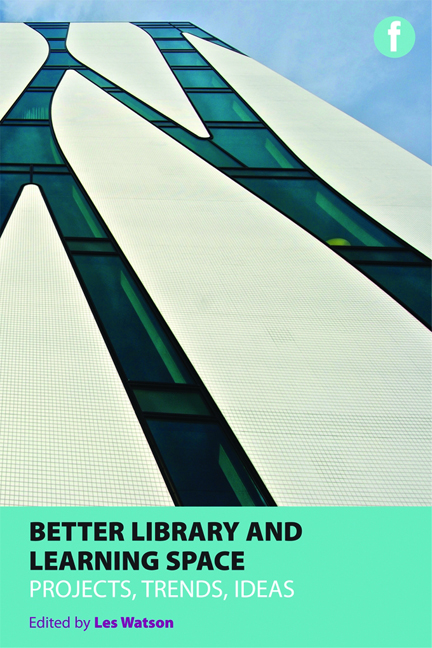Book contents
- Frontmatter
- Contents
- Case studies
- Acknowledgements
- Contributors
- Introduction – about this book
- PART 1 PROJECTS AND TRENDS
- PART 2 TRENDS AND IDEAS
- PART 3 IDEAS AND FUTURES
- Introduction
- 11 Beyond space: access is all – or is it?
- 12 Thinking inside the box
- 13 Nothing has changed/everything has changed – the enduring aspects of learning
- 14 Books, nooks and MOOCs
- 15 The researcher's view: context is critical
- 16 Libraries in the network society: evolution, revolution, extinction?
- 17 Powered by learning: developing models of provision to meet the expectations of new generations of students
- 18 The library has left the building
- 19 Beyond analogue: the learning studio as media-age library
- 20 3D libraries for 3D smarting
- 21 Learning landscapes, the library and the University of Lincoln: efficiency, effectiveness, expression and experimentation
- 22 Viral design: learners building better environments together
- 23 The interior designer's view
- 24 Furniture fit for the future – a brief exploration of library and learning furniture today and for the coming generation
- 25 Conclusions
- Index
12 - Thinking inside the box
from PART 3 - IDEAS AND FUTURES
Published online by Cambridge University Press: 08 June 2018
- Frontmatter
- Contents
- Case studies
- Acknowledgements
- Contributors
- Introduction – about this book
- PART 1 PROJECTS AND TRENDS
- PART 2 TRENDS AND IDEAS
- PART 3 IDEAS AND FUTURES
- Introduction
- 11 Beyond space: access is all – or is it?
- 12 Thinking inside the box
- 13 Nothing has changed/everything has changed – the enduring aspects of learning
- 14 Books, nooks and MOOCs
- 15 The researcher's view: context is critical
- 16 Libraries in the network society: evolution, revolution, extinction?
- 17 Powered by learning: developing models of provision to meet the expectations of new generations of students
- 18 The library has left the building
- 19 Beyond analogue: the learning studio as media-age library
- 20 3D libraries for 3D smarting
- 21 Learning landscapes, the library and the University of Lincoln: efficiency, effectiveness, expression and experimentation
- 22 Viral design: learners building better environments together
- 23 The interior designer's view
- 24 Furniture fit for the future – a brief exploration of library and learning furniture today and for the coming generation
- 25 Conclusions
- Index
Summary
Introduction
Much is said about transforming education. As architects and designers it is debatable as to whether we can influence pedagogical outcome … but we are eager to try. Through placemaking and the creation of better learning environments we can influence activity and behaviour in a creative, exciting and innovative way.
Since Socrates sat under a plane tree in ancient Greece, Cistercian monks occupied their monastic cells in the 11th century, merchants discoursed in the coffee houses of 17th century London and pupils were fearful in foreboding Victorian school houses … learning has been serendipitous. We learn, despite the space or building.
This chapter will illustrate how form and space provide ‘a wrap’ for learning environments – intentionally or otherwise – and how it can be improved. The architecture can work much harder to encourage the activity within the space – creating the joy of space and an exciting environment in which to learn.
I believe that as architects we need to establish objectives, then work within defined parameters. This should be considered as a creative challenge rather than a restrictive convention. It is a fundamental multidimensional assessment of light, space and technology and how they can best be combined architecturally … it is about ‘thinking inside the box’.
Many learning spaces now excel through designing from the inside out. We are not talking about simply interior design but true architecture where the inside of the building form and function is expressed in an intrinsic rather than superficial way – for example the Saltire Centre at Glasgow Caledonian University, where a range of learning spaces has been created, in part through orientation, circulation patterns, the permeability of the building and the environmental strategy. More recently some of the most exciting, imaginative environments have been created for technology and media-based companies such as Apple, Google, Microsoft, Pixar and Disney, embracing dynamic architectural spaces, the latest information and communication technology, smart furniture solutions, minimal storage, and bold use of colour and art to create a sense of place, which encourages inspiration and creative learning, and makes for a joyful working environment.
- Type
- Chapter
- Information
- Better Library and Learning SpaceProjects, trends and ideas, pp. 159 - 166Publisher: FacetPrint publication year: 2013



